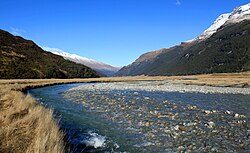Rees River
| Rees River | |
|---|---|
 | |
 | |
| Native name | |
| Location | |
| Country | New Zealand |
| Physical characteristics | |
| Mouth | |
• location | Glenorchy |
• elevation | 320 m |
| Length | 41 km |
| Basin size | 406 km2 |
| Discharge | |
| • average | 26 cumecs |
The Rees River (Māori language: Puahiri or Puahere)[1] is a headwater tributary of the Clutha River / Mata-Au that drains eastward of the main divide of the Southern Alps / Kā Tiritiri o te Moana in New Zealand. The river runs 41 km,[2] drains an area of 406 km2, and discharges into the head of Lake Wakatipu at Glenorchy. Bound by the Richardson (Whakaari) Mountains[3] to the east and the Forbes Mountains[4] to the west, its snow-covered headwaters rise above 2000 m.
The upper parts of the Rees River occupy a formerly glaciated valley that was fed by the Tyndall Glacier, which now drains into the adjacent Dart Valley. Below Rees Saddle the river valley is constrained by a series of steep alluvial fans that are fed from tributary basins.[2] The lithology of the Rees catchment is highly erodible schist of the Aspiring lithologic association.[5] The underlying schist is highly fissive due to its fine-grain, segregated quart-feldspar-mica composition.[6]
The Rees valley, covered in tussock and native forest, is a popular location for recreational fly fishing, pack rafting and tramping, including the Rees and Dart Tracks, a five-day loop which crosses from the upper reaches of the Rees into the valley of the Dart River / Te Awa Whakatipu.[7] However, the steep hillsides, easily erodible rock, proximity to the Alpine Fault, and intense rainfalls contribute to geohazard risks in the region. A debris flow swept away a hiker during a river crossing in an unnamed tributary in the Upper Rees Valley near Cleft Peak in January 2002.[6]
The Rees river and valley get their gazetted name[8] from the high country station, was originally part of the runs established by William Gilbert Rees, the first sheep farmer in the Wakatipu Basin.[9] Ownership of the station has been in the Scott family since 1905; the Rees Valley Station is maintained in perpetuity as a part of Crown Pastoral Lease.
In popular culture
The lower Rees Valley, which continues to operate as a beef and sheep grazing farm, was a filming location for Mission: Impossible – Fallout,[10] and the television drama series Top of the Lake.
See also
References
- ^ "Puahiri / Puahere". Kā Huru Manu. Nga Rūnanga o Ngāi Tahu. Retrieved 2 February 2021.
- ^ a b Cook, Simon J.; Quincey, Duncan J.; Brasington, James (2 January 2014). "Geomorphology of the Rees Valley, Otago, New Zealand". Journal of Maps. 10 (1): 136–150. doi:10.1080/17445647.2013.863744. ISSN 1744-5647.
- ^ "Place name detail: "Whakaari"". New Zealand Gazetteer. New Zealand Geographic Board. Retrieved 25 July 2022.
- ^ "Place name detail: "Forbes Mountains"". New Zealand Gazetteer. New Zealand Geographic Board. Retrieved 25 July 2022.
- ^ Turnbull, I. M. (2000). Geology of the Wakatipu Area, Institute of Geological and Nuclear Sciences 1:250,000 geological map 18. 1 sheet + 72 p. Lower Hutt, New Zealand, Institute of Geological and Nuclear Limited.
- ^ a b McSaveney, M.J., Glassey, P.J. 2002. The fatal Cleft Peak debris flow of 3 January 2002, Upper Rees Valley, West Otago Institute of Geological & Nuclear Sciences science report 2002/03. 28 p.
- ^ "Rees-Dart Track". New Zealand Department of Conservation. Retrieved 28 August 2009.
- ^ "Place name detail: Rees River". New Zealand Gazetteer. New Zealand Geographic Board. Retrieved 2 February 2021.
- ^ Reed, A. W. (1975). Place names of New Zealand. Wellington: A.H. & A.W. Reed Ltd. p. 357
- ^ "A cruise in Queenstown". Otago Daily Times. 2018.
